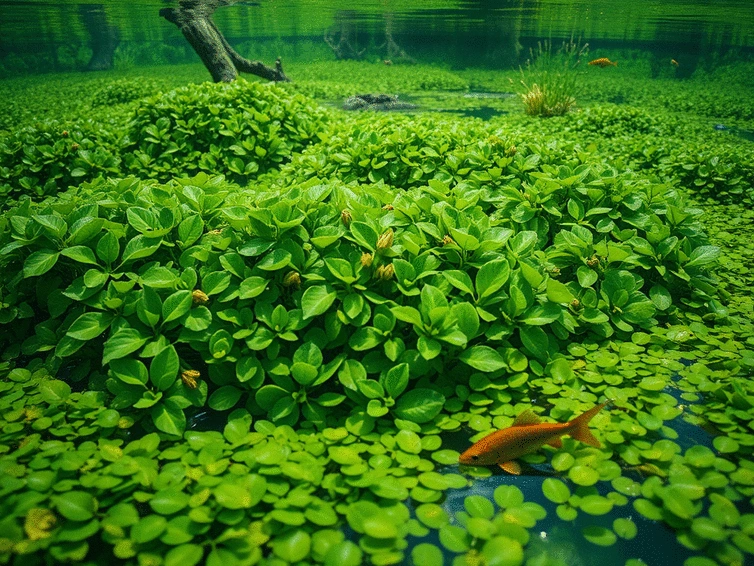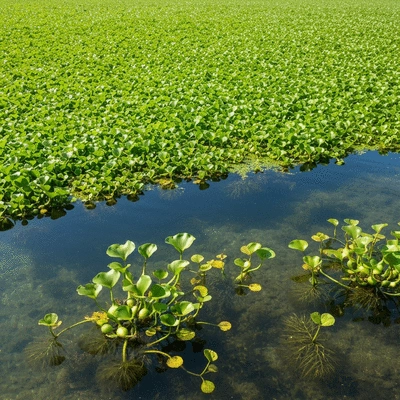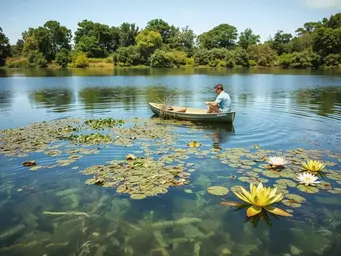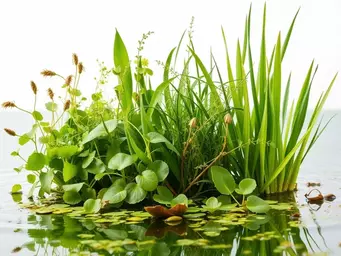Reduced Native Biodiversity
Invasive plants outcompete native species, leading to ecosystem imbalance and affecting the entire food web.

What if the water bodies you cherish are silently being choked by invasive species? Understanding the profound impact of invasive aquatic plants can empower you to take action and protect these vital ecosystems.
Invasive aquatic plants significantly degrade water quality and disrupt ecosystems through several key mechanisms:
Invasive plants outcompete native species, leading to ecosystem imbalance and affecting the entire food web.
Dense invasive mats block sunlight and consume oxygen during decomposition, creating "dead zones" for aquatic life.
They fuel excessive nutrient enrichment and disrupt natural cycles, leading to algal blooms and increased sedimentation.
Invasives cause flooding risks, restrict recreation, and negatively impact fisheries, creating significant economic burdens.
Understanding the intricate balance of our aquatic ecosystems is crucial, especially when it comes to the influence of invasive aquatic plants. These plants not only threaten native species but also play a significant role in the overall quality of water. In this section, we’ll explore what invasive aquatic plants are, the common types affecting our waterways, and their wide-ranging impacts on both the environment and human communities.
Invasive aquatic plants are species that are non-native to a specific ecosystem and can cause harm to the environment, economy, or human health. These plants often outcompete native vegetation, disrupting the natural balance and leading to a decline in biodiversity. Recognizing these plants is essential for effective management and preservation of our water bodies.

At Aquatic Weed Solutions, we aim to equip landowners, ecologists, and waterway managers with the knowledge to identify these species effectively. By understanding the traits that define invasive plants, we can take proactive measures to protect our ecosystems.
These invasive species are just a few examples of how aquatic plants can impact our waterways. Understanding their characteristics helps landowners and managers make informed decisions about control and management strategies.
Invasive plants significantly reduce native plant diversity, leading to ecosystem imbalance. When native species decline, the entire food web is affected, as many aquatic organisms rely on these plants for habitat and nutrition. As an ecologist, I have witnessed firsthand how this reduction can ripple through the ecosystem, affecting fish populations and other wildlife.
It’s important to realize that the loss of native plants not only impacts wildlife but also the overall health of the waterway. Healthy ecosystems support a variety of species, and maintaining this diversity is vital for resilience against environmental changes.
The introduction of invasive species can lead to disruptions in aquatic food webs. Invasive plants can outcompete native vegetation, affecting the availability of food and shelter for various aquatic organisms. For instance, when hydrilla proliferates, it can quickly dominate a water body, leaving little room for native plants that provide essential habitat for fish and invertebrates.
This disruption not only impacts individual species but can also lead to broader ecological consequences, such as population declines and shifts in community structure. Recognizing these dynamics is crucial for restoring balance and ensuring the health of our waterways.
One of the most significant consequences of invasive plants is the alteration of habitats. As these plants establish themselves, they can change the physical and chemical properties of the water, leading to habitat degradation. This alteration can affect everything from water temperature to nutrient cycling, making it difficult for native species to thrive.
At Aquatic Weed Solutions, we focus on educating communities about the importance of managing these invasive species to protect and restore habitats. By implementing effective management strategies, we can help prevent further degradation and promote healthier aquatic environments.
One of the primary ways invasive aquatic plants degrade water quality is through oxygen depletion. As these plants proliferate, they can cover the surface of water bodies, reducing the amount of sunlight that penetrates and leading to lower levels of oxygen. This depletion significantly affects fish and other aquatic organisms, which rely on oxygen-rich environments to survive.

Understanding the relationship between invasive plants and oxygen levels is critical for anyone involved in waterway management. It's vital to recognize the signs of oxygen depletion early to take appropriate action.
Eutrophication is a process that leads to excessive nutrient enrichment in water bodies, often fueled by the growth of invasive plants. When these plants die and decompose, they consume oxygen in the process, exacerbating the problem of low oxygen levels. This cycle can lead to the creation of dead zones, where aquatic life cannot survive.
To combat eutrophication, it’s essential to monitor nutrient levels and manage invasive populations effectively. By maintaining a healthy balance, we can help restore the natural beauty and functionality of our waterways.
Invasive species can also disrupt nutrient cycling within aquatic ecosystems. They alter the natural processes that regulate nutrient availability, leading to increased sedimentation and further degradation of water quality. This disruption can make it challenging for native plants to establish themselves and thrive.
At Aquatic Weed Solutions, we emphasize the importance of understanding these dynamics to foster healthier ecosystems. By implementing targeted management strategies, we can mitigate the negative impacts of invasive species and promote sustainable practices.
Another consequence of invasive aquatic plants is the proliferation of algal blooms. These blooms can result from nutrient overloads often associated with invasive species. Algal blooms not only diminish water clarity but also produce toxins that can harm aquatic life and pose health risks to humans.
Recognizing the signs of algal blooms and understanding their causes is crucial for anyone involved in waterway management. By educating communities and implementing effective management practices, we can work to ensure clean, healthy water for all.
Hydrilla is notorious for its rapid growth and ability to thrive in various aquatic ecosystems. Its resilience allows it to outcompete native species effectively, leading to serious management challenges. In my experience, dealing with hydrilla requires a comprehensive approach, including early detection and sustained management efforts.
This invasive species presents unique management challenges. Its ability to grow densely can obstruct water flow and disrupt recreational activities. Effective control measures often involve a combination of mechanical and chemical strategies to reduce its impact.
Phytoplankton play a crucial role in aquatic ecosystems, and their dynamics can be significantly altered by the presence of invasive species. When invasive plants dominate, they can affect the light penetration and nutrient availability, which ultimately influences phytoplankton growth and the entire food web.
Invasive aquatic plants pose substantial economic and infrastructure challenges. For instance, the National Invasive Species Information Center highlights the extensive economic and social impacts of invasive species, which can cost billions annually in damages and control efforts.
The presence of invasive aquatic plants can lead to increased flooding risks due to their ability to obstruct water flow. This obstruction can result in property damage and water scarcity issues for surrounding communities, making effective management essential.
Invasive species can restrict recreational activities such as boating and fishing, leading to economic impacts on local communities. The loss of access to water bodies can affect tourism and local businesses, highlighting the need for proactive management strategies.
Fisheries are particularly vulnerable to the effects of invasive species. Changes to aquatic habitats can affect fish populations, leading to declines in local fishing industries. Understanding these impacts is essential for developing effective management plans that protect both the environment and local economies.
Implementing strategies for early detection and rapid response is crucial in managing invasive aquatic plants. By identifying and addressing infestations early, we can prevent significant damage to our ecosystems. Regular monitoring and community engagement play vital roles in this proactive approach.
Effective management of invasive species often relies on strong legislative frameworks. By understanding local regulations and policies, we can better advocate for actions that support the protection of our waterways and aquatic ecosystems.
Engaging the community is essential for effective management of invasive aquatic plants. Public awareness campaigns can educate individuals about the impacts of these species and encourage community involvement in management efforts. When communities collaborate, they can foster healthier ecosystems.
Biomanipulation and restoration ecology techniques are innovative approaches to managing invasive plants. These methods focus on restoring ecological balance by reintroducing native species and enhancing natural controls. By embracing these strategies, communities can work towards achieving sustainable waterway management.
The future of invasive species control lies in emerging technologies. Innovations such as genetic engineering and drones for monitoring invasive populations are being explored as potential solutions. Staying informed about these advancements can help us adopt more effective management strategies.
Understanding regional variations in invasive species impact and management approaches is crucial for tailoring strategies to specific ecosystems. Different areas may face unique challenges, requiring customized solutions to effectively address invasive threats. For instance, research published in the Marine and Freshwater Behaviour and Physiology journal discusses how factors like current speed can influence the distribution of invasive species in different environments.
Climate change is influencing the dynamics of invasive species, altering their ranges and impacts on native ecosystems. As we adapt to these changes, it’s vital for research and management practices to consider climate factors to mitigate potential consequences. A white paper from the Invasive Species Advisory Committee highlights the significant connection between climate change and invasive species, noting how changing conditions can favor invasive growth and expansion.
What do you think about the impact of invasive aquatic plants on local ecosystems? Share your thoughts and experiences below:
As we reflect on the significant challenges posed by invasive aquatic plants, it's crucial to understand their ecological and economic repercussions. These species not only threaten the delicate balance of our waterways but also affect the communities that depend on them. The consequences of their presence are widespread and profound, impacting everything from biodiversity to local economies.
In short, here are some key points to remember about the impact of invasive aquatic plants:
Understanding the impact of these invasive species is vital for anyone involved in aquatic ecosystem management. It's not just about the plants themselves; it's about the broader implications for our water bodies and communities. One of the major takeaways is the stark reality of how these invasive plants contribute to the decline of biodiversity within our ecosystems.
Additionally, the economic consequences can be substantial. Communities may face increased costs related to water treatment and management, impacting everything from property values to local tourism. The following points encapsulate the ecological and economic consequences:
Biodiversity is essential for the resilience of aquatic ecosystems. It ensures that natural processes function smoothly, maintaining the health and sustainability of our water bodies. When invasive species disrupt this balance, it can lead to a cascade of negative effects, including the loss of native species that are critical for maintaining ecological integrity.
By nurturing biodiversity, we can bolster the adaptability of our ecosystems in the face of various environmental pressures, including climate change. As an ecologist, I cannot stress enough the importance of preserving these unique habitats for future generations.
In addition to the challenges presented by invasive plants, we must also consider the impact of chemical pollution on aquatic life. Chemicals from agricultural runoff, industrial discharges, and household waste can further degrade water quality, creating a perfect storm for our waterways. This pollution can exacerbate the effects of invasive species, leading to more severe ecological disruptions.
As we seek to understand these complex interactions, it's essential to combine our efforts in managing invasive species with broader initiatives aimed at reducing chemical inputs into our waterways. Every action counts, and together, we can strive for healthier aquatic ecosystems.
Now, let’s discuss how we can all contribute to managing these invasive species! As individuals and members of our communities, our actions can make a significant difference in preserving our aquatic ecosystems. Here are some practical steps anyone can take:
Each of these actions can help mitigate the effects of invasive species and foster healthier environments. At Aquatic Weed Solutions, we believe that informed and engaged communities are key to successful ecological management.
Advocacy for robust policies and legislation is another critical avenue for effecting change. By backing laws and regulations that promote sustainable practices and support invasive species management, we can influence systemic change. Engage with local policymakers and share your concerns regarding aquatic health and management.
Remember, your voice matters! Collective advocacy can lead to significant improvements in how we handle invasive species challenges at both local and state levels.
Raising public awareness is essential for aquatic conservation. Informing the public about the importance of maintaining aquatic ecosystems and the threats posed by invasive species can inspire action and support. Consider hosting workshops, creating informative content, or collaborating with schools to educate others.
When communities come together to share knowledge, we not only strengthen our resolve but also empower others to join the fight against invasive species. Together, we can enhance the health of our waterways!
As we move forward, it’s essential to keep the conversation about aquatic plant management alive. Ongoing research and data collection are crucial to understanding the dynamics of invasive species and their impacts. The more we learn, the better equipped we are to develop effective management strategies.
Encouraging public participation in ecosystem conservation initiatives can foster greater community ownership and responsibility toward our waterways. This collaborative spirit is what will ultimately lead to meaningful change.
Research is the backbone of effective management strategies. By funding and supporting studies on invasive species, we can uncover new methods for control and prevention. This ongoing investigation helps us adapt our approaches to meet emerging challenges and changing conditions in our ecosystems.
Engagement does not stop at awareness; it extends to action! Encourage your friends, family, and neighbors to participate in local environmental activities. Whether it’s volunteering for restoration projects or attending community meetings, every effort counts towards nurturing a sustainable aquatic environment.
Finally, collaborative efforts in watershed management can lead to better outcomes for both ecosystems and communities. By working together, stakeholders can share resources, knowledge, and experiences that enhance overall effectiveness in managing invasive species.
As we wrap up this section, I hope you're inspired to take action and engage in conversations about our aquatic ecosystems. The future health of our waterways depends on each of us, and together, we can make a difference!
Here is a quick recap of the important points discussed in the article:
Managing Aquatic Weeds Effectively

As we delve into the hidden challenges of our water ecosystems, understanding the role of aquatic we
Impact of Aquatic Weeds on Recreation

As we dive into the world of aquatic ecosystems, the presence of invasive aquatic weeds may not only
Understanding Aquatic Weed Varieties

What if understanding aquatic weeds could be the key to restoring our waterways? As we dive deeper i
Managing Aquatic Weeds Effectively
Impact of Aquatic Weeds on Recreation
Understanding Aquatic Weed Varieties
Integrated Aquatic Weed Management Methods
Integrated Approaches to Aquatic Weeds